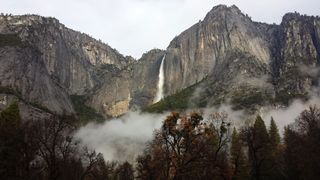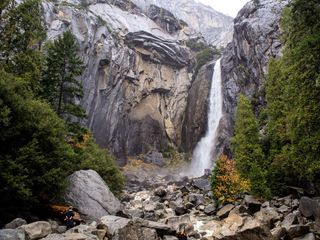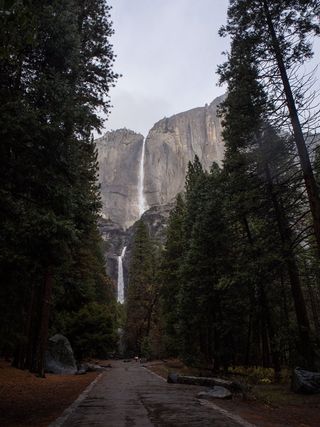Yosemite Falls Revives After Hard Rain

Drought-stricken Yosemite Falls, one of Yosemite National Park's top attractions, roared back to life Wednesday (Dec. 3). The falls reappeared in full glory after two days of significant rain in the Sierra Nevada, the National Park Service said. The tallest waterfall in North America and a popular stop for park visitors, Yosemite Falls went dry in early summer because of California's exceptional drought.
"To see Yosemite Falls coming to life this morning is truly exhilarating," Don Neubacher, Yosemite National Park Superintendent, said in a statement Wednesday. "This is a wonderful time to visit Yosemite National Park, and the waterfalls just add to the magnificence of the park."
Water now flows freely at Yosemite Falls, Bridalveil Fall, Cascade Fall and Yosemite's other amazing waterfalls, fed by a storm system that soaked San Francisco with more than 4 inches (10 centimeters) of rain on Wednesday and dropped 6 inches (15 cm) of rain and snow in the mountains. Despite the storms, all roads into the park (Highways 140, 120 and 41) are open, the park service said.

Yosemite Falls is a composite of three waterfalls that rush 2,425 feet (739 meters) down the steep granite cliffs of Yosemite Valley. The Upper Fall and Lower Fall can be easily spotted from an accessible shuttle stop at the base of the Lower Falls, or a 1-mile (1.6 kilometers) loop trail. A series of five smaller drops connects the two steep plunges, collectively called the Middle Cascades. [In Photos: Best National Parks to Visit During Winter]
Yosemite Falls and other park waterfalls typically run low in the summer because their water comes from snowmelt in the mountains above Yosemite Valley. The peak flow is usually during May and June, with the falls dwindling to a trickle by August, or even going dry. Winter rains then revive the spectacular gushers. About half of California's annual precipitation falls between December and February.

But in the last three years, California's extreme drought has shrunk the mountain snowpack to just 20 to 30 percent of its normal volume, leaving little meltwater to fuel Yosemite's waterfalls. During the summer, the waterfalls were bone-dry, except during temporary deluges from thunderstorms. And earlier this year, in February, Horsetail Fall threatened to run dry during its famous "firefall" conditions, when the angle of the sun illuminates the waterfall with a fiery glow.
All of California remains in some kind of drought condition, according to a report released Thursday (Dec. 4) from the U.S. Drought Monitor. Some 55 percent of the state is in exceptional drought, including the region that encompasses Yosemite National Park.
Sign up for the Live Science daily newsletter now
Get the world’s most fascinating discoveries delivered straight to your inbox.

Follow Becky Oskin @beckyoskin. Follow Live Science @livescience, Facebook & Google+. Originally published on Live Science.

